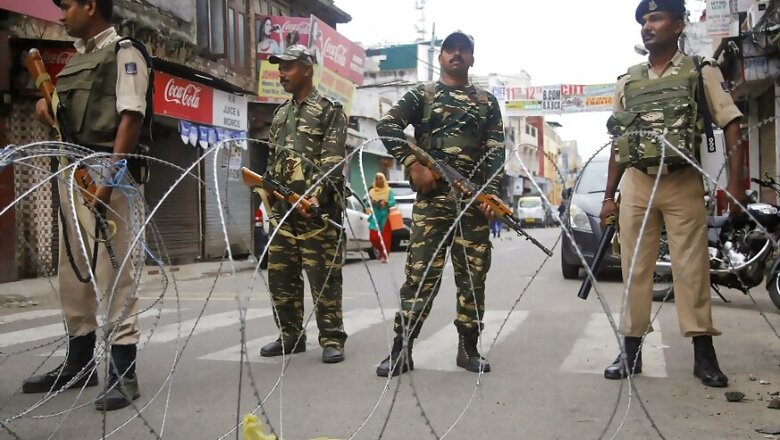
views
Over 70 days since the government scrapped Article 370, a two-part News18 series looks at the ramifications of the move and the way forward. Part 2 will look at some suggested measures to move towards conflict management
Today, there are two different narratives about Jammu and Kashmir. The first and more dominant narrative is that Article 370 was the root cause of all the problems in the state. It bred terrorism, encouraged secessionism, and was used by the local politicians to keep themselves in power with no concern about their people. Now that this article stands diluted, it will help the population bond completely with the Indian nation and bring peace and development to this troubled region.
The second narrative is that Article 370 was the bridge that linked the people of Jammu and Kashmir with India. Now that this bridge has been burned, Kashmiri Muslims of the Valley, who are at the forefront of insurgency, will get further alienated. This will lead to greater violence, a rise in secessionist tendencies, and impede any effort towards conflict resolution.
One complication in finding solutions to intractable conflicts is to identify the nature of the problem correctly. The cause of the Kashmir problem has been variously attributed to the existence of Article 370, political mismanagement in the state, and Pakistan's support to terrorism. While all these reasons are present in Kashmir, one area that is rarely discussed is the salience of ethnic identity as a significant reason for the ongoing conflict.
In their book Ethnic Conflict, Karl Cordell and Stefan Wolff define ethnic conflict as one "in which the goals of at least one party are defined in (exclusively) ethnic terms, and the primary fault line of confrontation is one of ethnic distinctions”. Considering the fact that the violence is today mostly carried out by Muslims of the Kashmir Valley, the Kashmiri Pandits have been driven out from the Valley, and 'threat to Kashmiri identity' is a recurrent theme, it is clear that ethnicity plays a key role.
In attempting to find solutions, it is useful to do a wide-ranging analysis of the reasons for rebellion by ethnic minorities. Local conditions will influence the actions of any group, but some common themes run through ethnic conflicts around the world, and in identifying these, we could find some answers to the problem in Jammu and Kashmir.
Looking back into history, it is apparent that nation-building in countries that became independent after World War 2 was one reason for the rise of many ethnic conflicts around the world. As the central state authority in the newly formed countries moved to consolidate its control over territories and resources, it clashed with minorities that had historically enjoyed a more autonomous status. In India, we saw this happening in the Northeast, starting with the Nagas, almost immediately after Independence. The roots of the Kashmir conflict also lie in the demand for greater autonomy on the basis of the Instrument of Accession.
The state-making process in older nation-states had evolved over three to four centuries, but this luxury was not available to the newly independent countries. As pointed out by Mohammed Ayoob in his article State Making, State Breaking, and State Failure, “The lack of adequate time and normative constraints imposed on state makers make their task very difficult and encourage the emergence of secessionist movements that challenge the state’s authority and lay the basis for intrastate conflict.” The normative constraints that Ayoob refers to are the attitudes of the international community towards human rights that were codified with the birth of the United Nations. These constraints had not applied to the older liberal democracies in the international system.
However, it would also be too simplistic to lay all the blame for ethnic conflicts on nation-building. Numerous ethnic minorities around the world have peacefully accepted their place in the nation. There is a vast body of work on why ethnic conflicts break out, but some of the commonly accepted reasons can be identified. Ted Robert Gurr has explored ethnic conflicts by using the Minorities at Risk dataset for 233 ethnic groups. He finds that the causes of conflict range from the salience of the ethnocultural identity, incentives for political action triggered by a loss of political autonomy or resentment about past losses, to the capacity for collective action, which is strengthened by the geographic concentration of the group and external support.
David Lake and Donald Rothchild, in their influential article Containing Fear: The Origins and Management of Ethnic Conflict, have argued that ethnic conflict is most often a result of collective fears of the future. They write, “As groups begin to fear for their safety, dangerous and difficult-to-resolve dilemmas arise that contain within them the potential for tremendous violence…Ethnic activists and political entrepreneurs, operating within groups, build upon these fears and insecurity and polarize society. Political memories and emotions also magnify these anxieties, driving groups further apart.”
Many of the causes of ethnic conflicts discussed above are present in Kashmir. There is great salience of the Kashmiri identity, the group is geographically concentrated in the Kashmir region, there is a polarisation between communities within the state and external support from Pakistan. The recent loss of political autonomy and worries about majoritarian politics also present the Kashmiris with an uncertain future.
The political elite in Kashmir and the separatists have played on the fears of the community and made little attempt to look for solutions to this decades-old problem. The separatists, in particular, adopted an extremely rigid stance and sought the involvement of Pakistan in the Kashmir issue, a position that was unacceptable to the Indian government.
Looking holistically at the conflict in Jammu and Kashmir, it is apparent that a complex set of factors has resulted in this long-festering problem. Solutions focusing on jobs and economic development will not be adequate, and a more comprehensive strategy will have to be crafted.
(The author is former Northern Commander, Indian Army, under whose leadership India carried out surgical strikes against Pakistan in 2016. Views are personal)




















Comments
0 comment